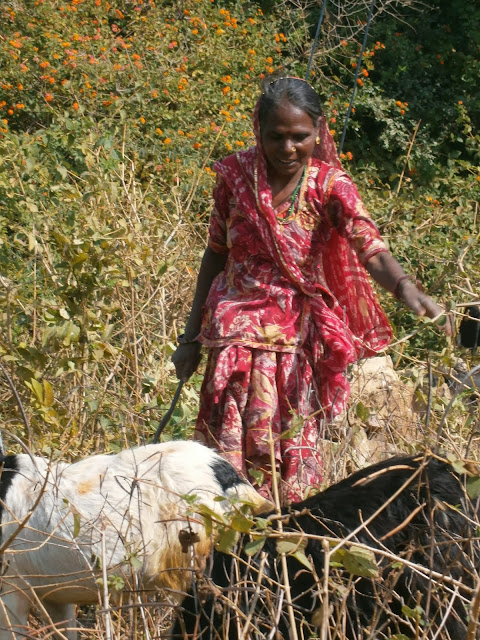Indian women --incredible beauty, warmth, grace and strength. And of course colors. But if it is a hard life for most Indians, it is an even harder life for females, particularly rural females. We spent the day with Dana and Allison on a wonderful trek in rural India with a guide, Danraj, from the rural village. We visited a village and a small rural Hindu temple and got a very, very tiny look at the life of the majority of Indians who live in the countryside.
On average, rural women spend over an hour a day collecting water -- and for some it is far more. Four hours is the average time per week devoted to collecting firewood. Everywhere we looked, women were responsible for herding the goats. They may be short of stature, but they are very, very long on strength due to daily labor demands.


While on the road, our guide introduced us to three women and their herd of goats. It was obvious that we were with rural women, living as their ancestors had lived for centuries. Three generations of women -- grandmother, mother and daughter -- walking with their goats. Timeless. Wonderful....
...the hard part, though, is that while they all were connected at present, their "family" had changed for them over time. The grandmother married her husband and moved into his house in another village. It is not acceptable for girls to marry into families of the same village. Almost all rural women move to new villages, with many living far away from their home village. She therefore may not have had much contact with her birth family after marriage.
The mother also came from another village to join the household and thus the grandmother is her mother-in-law, not her mother. And the young girl to the left? She will soon leave her mother and grandmother and her village to join the family of her husband. A painful time for all three women.
In the village Danraj (on right) introduced us to his sister's two kids -- a boy and a girl (see below). His sister lives with her husband about 10 km away from Danraj's family village. She moved there after the arranged marriage. Her son will likely live out his life in the Mom's village -- and provide a semblance of economic security to his mother. Her daughter will almost definitely move away upon marriage. Her economic future will be tied to her new husband's family.
If you are a woman, it really pays to have a son. Your family stays close by, and your son will likely provide for any economic security she may have in later years. Not so with a daughter. Parents say they would never ask their daughters for help. She is tied to her new family and ties to the birth family are -- if not severed -- severely limited due to constraints on her time and needing to obtain permission from her husband or mother-in-law to visit her parents.
The reality of all this is much closer to us now that we are here. Real people, real lives. This girl's life has many complications ahead.









wonderful post
ReplyDelete